|







|
3. Laboratory of
General and Inorganic Chemistry (Faculty of Science, University of
Zagreb)
Laboratory of General and Inorganic Chemistry, Department of Chemistry,
became a center of crystallography led by Drago Grdenić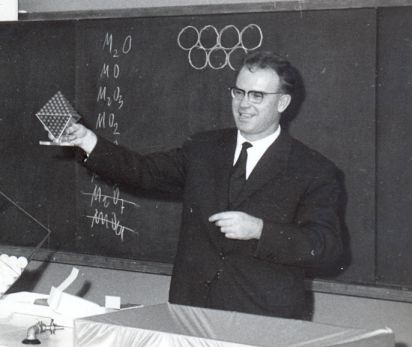 from 1952. A
paper published in Acta Cryst. in 1952
describing the projection of electron density distribution in the
crystal of mercury diethylene oxide was the first in this field in
Croatia and this part of Europe. In 1955/56 Grdenić spent six months in
the laboratory of Dorothy Hodgkin working on the structure of
ferroverdin. Upon returning to Zagreb Grdenić continued his research of
mercury compounds for which he is well known. The review article
entitled The Structural Chemistry of Mercury published in
Quart. Rev. Chem. Soc. in 1965, in which the author laid down
the rules of the structural chemistry of mercury, is still one of the
most cited papers of a Croatian chemist.
from 1952. A
paper published in Acta Cryst. in 1952
describing the projection of electron density distribution in the
crystal of mercury diethylene oxide was the first in this field in
Croatia and this part of Europe. In 1955/56 Grdenić spent six months in
the laboratory of Dorothy Hodgkin working on the structure of
ferroverdin. Upon returning to Zagreb Grdenić continued his research of
mercury compounds for which he is well known. The review article
entitled The Structural Chemistry of Mercury published in
Quart. Rev. Chem. Soc. in 1965, in which the author laid down
the rules of the structural chemistry of mercury, is still one of the
most cited papers of a Croatian chemist.
A
Unicam camera and three Weissenberg goniometers were the first tools.
Later on, the Laboratory was equipped with a General Electric powder
diffractometer. The first four-circle single-crystal Philips
diffractometer was bought in 1974 and that modern instrument was a great
advance in crystal structure determination. Many of Grdenić's students
and coworkers at the Faculty of Science were involved in solving
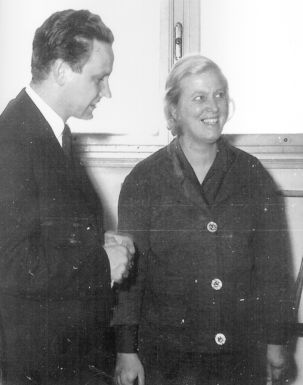 crystal
structures: Boris Kamenar, Milan Sikirica (intermetallic compounds,
organomercury compounds), Ante Nagl, Milenko Bruvo, Zvonimir Ban, Milan
Pušelj, Antonija Hergold-Brundić, Zora Popović, Dubravka
Matković-Čalogović (organomercury compounds). Ban and Pušelj were
working mainly on intermetallic compounds and metal peroxides by powder
diffraction. Boris Kamenar was a visiting scientist in Dorothy Hodgkin's
Lab, University of Oxford in 1964/65, in All Souls College in 1971/72,
and three times in New Zealand, once at the University of Auckland
and
twice at the Massey University. In Zagreb, he was investigating with his
group structures of inorganic, organometallic and organic compounds,
complex compounds – especially those of molybdenum and vanadium (Maja
Penavić, Branko Kaitner, Neven Strukan, Berislav Marković), organic
compounds – pharmaceuticals such as that of azythromycin (Zitromax) and
its derivatives (Draginja Mrvoš-Sermek). Ivan Vicković worked on
computer programs in structural analysis, collaborated with Davide
Viterbo in Torino 1976/77, and later at Texas Christian University, Fort
Worth, and in Groningen). In his doctoral thesis (1977), he was among
the first in Croatia to use direct methods for crystal structure
analysis. crystal
structures: Boris Kamenar, Milan Sikirica (intermetallic compounds,
organomercury compounds), Ante Nagl, Milenko Bruvo, Zvonimir Ban, Milan
Pušelj, Antonija Hergold-Brundić, Zora Popović, Dubravka
Matković-Čalogović (organomercury compounds). Ban and Pušelj were
working mainly on intermetallic compounds and metal peroxides by powder
diffraction. Boris Kamenar was a visiting scientist in Dorothy Hodgkin's
Lab, University of Oxford in 1964/65, in All Souls College in 1971/72,
and three times in New Zealand, once at the University of Auckland
and
twice at the Massey University. In Zagreb, he was investigating with his
group structures of inorganic, organometallic and organic compounds,
complex compounds – especially those of molybdenum and vanadium (Maja
Penavić, Branko Kaitner, Neven Strukan, Berislav Marković), organic
compounds – pharmaceuticals such as that of azythromycin (Zitromax) and
its derivatives (Draginja Mrvoš-Sermek). Ivan Vicković worked on
computer programs in structural analysis, collaborated with Davide
Viterbo in Torino 1976/77, and later at Texas Christian University, Fort
Worth, and in Groningen). In his doctoral thesis (1977), he was among
the first in Croatia to use direct methods for crystal structure
analysis.
In
1981, Milan Sikirica managed to get funds for another Philips
diffractometer. So, one instrument was with molybenum and the other with
copper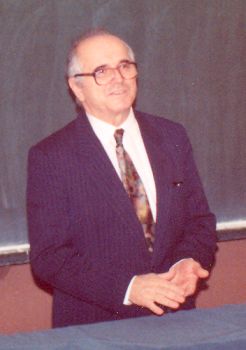 radiation. They served well for many years until an Oxford diffracton
Xcalibur 3 with a CCD camera was bought at the end of 2002, on the
fiftieth anniversary of the Laboratory of General and Inorganic
Chemistry. The first doctoral thesis on protein crystallography was that
of Dijana Matak-Vinković. Mladen Vinković was mainly solving structures
of pharmaceuticals and then left for the pharmaceutical company Pliva,
Zagreb, and later both Dijana and Mladen Vinković went to Cambridge.
Ante Nagl left for the Faculty of Textile Technology, University of
Zagreb. A small crystallography group work there with him (Gordana
Pavlović, Mario Cetina).Ernest Meštrović formed a crystallography group
in the pharmaceutical company Pliva (Nada Košutić-Hulita, Maja Devčić).
radiation. They served well for many years until an Oxford diffracton
Xcalibur 3 with a CCD camera was bought at the end of 2002, on the
fiftieth anniversary of the Laboratory of General and Inorganic
Chemistry. The first doctoral thesis on protein crystallography was that
of Dijana Matak-Vinković. Mladen Vinković was mainly solving structures
of pharmaceuticals and then left for the pharmaceutical company Pliva,
Zagreb, and later both Dijana and Mladen Vinković went to Cambridge.
Ante Nagl left for the Faculty of Textile Technology, University of
Zagreb. A small crystallography group work there with him (Gordana
Pavlović, Mario Cetina).Ernest Meštrović formed a crystallography group
in the pharmaceutical company Pliva (Nada Košutić-Hulita, Maja Devčić).
Today there are four groups working on structural chemistry in the
Laboratory of General and Inorganic Chemistry.
The major research
interest of Branko Kaitner's group is the study of intermolecular
interactions and their effect on structures and properties of molecular
solids. The research topic is approached by synthesis, crystallisation
and crystal structure determination. X-ray crystallography is combined
with other solid state analytical methods. Model molecules for study of
polar interactions are organic salts and triacylmethanes. Schiff bases
and
b-diketones
are employed for study of intra- and intermolecular hydrogen bonding.
Coordination
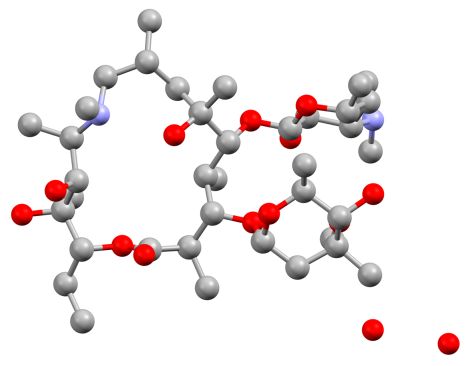 compounds
of transition metals with the above mentioned organic molecules are also
studied. The interest
of the Zora Popović's group is focused on preparation and structure
determination of metal complexes. Complexes of the late 3d-block as well
as group 12 metals with small organic molecules of biological importance
are investigated. The intention is to understand the interactions in the
crystal structure and to elucidate their role on the formation of
polymorphic forms and co-crystals with the help of computational
approach. Several younger crystallographers are now working in Marina
Cindrić's group on
synthesis and structures of anion-directed self-assembly of flexible
ligands into anion-specific and highly symmetrical organic solids,
complex compounds, coordination polymers and polyoxometalates of
vanadium, molybdenum and tungsten; polyoxometalates coordinated with
organic or complex molecules and their stability; complex compounds
with biologically active molecules as ligands (amino acids, pyridoxal
derivatives, thiosemicarbazones). They are investigating the catalytic
role of vanadium and molybdenum in the reactions of synthesis of new
biologically active molecules.
Dubravka Matković-Čalogović leads a group working on small molecules and
also on protein crystallography (specialization in that field in
Giuseppe Zanotti's group in Padova 1997/98 and later with Guy Dodson in
York). Recently she was a Fulbright fellow at the University of Kansas
Medical Center, Kansas City. Interests of her group are structures of
biological macromolecules: insulin with zinc replaced by other metal
ions, halogen derivatives of insulin (Biserka Prugovečki);
enzymatic activity of
tyrosine phenol-lyase (TPL) - detailed structural analysis of native and
mutated forms of TPL in complexes with the substrate analogues or other
molecules participating in TPL catalyzed reactions; structure of bovine
3-hydroxyanthranilate 3,4-dioxygenase. Small molecule crystallography: model
systems of enzymes based on “small” molecules,
supramolecular
architectures (Nenad Judaš).
Undergraduate and postgraduate courses on crystallography and crystal
structure analysis are taught at the Department of Chemistry. compounds
of transition metals with the above mentioned organic molecules are also
studied. The interest
of the Zora Popović's group is focused on preparation and structure
determination of metal complexes. Complexes of the late 3d-block as well
as group 12 metals with small organic molecules of biological importance
are investigated. The intention is to understand the interactions in the
crystal structure and to elucidate their role on the formation of
polymorphic forms and co-crystals with the help of computational
approach. Several younger crystallographers are now working in Marina
Cindrić's group on
synthesis and structures of anion-directed self-assembly of flexible
ligands into anion-specific and highly symmetrical organic solids,
complex compounds, coordination polymers and polyoxometalates of
vanadium, molybdenum and tungsten; polyoxometalates coordinated with
organic or complex molecules and their stability; complex compounds
with biologically active molecules as ligands (amino acids, pyridoxal
derivatives, thiosemicarbazones). They are investigating the catalytic
role of vanadium and molybdenum in the reactions of synthesis of new
biologically active molecules.
Dubravka Matković-Čalogović leads a group working on small molecules and
also on protein crystallography (specialization in that field in
Giuseppe Zanotti's group in Padova 1997/98 and later with Guy Dodson in
York). Recently she was a Fulbright fellow at the University of Kansas
Medical Center, Kansas City. Interests of her group are structures of
biological macromolecules: insulin with zinc replaced by other metal
ions, halogen derivatives of insulin (Biserka Prugovečki);
enzymatic activity of
tyrosine phenol-lyase (TPL) - detailed structural analysis of native and
mutated forms of TPL in complexes with the substrate analogues or other
molecules participating in TPL catalyzed reactions; structure of bovine
3-hydroxyanthranilate 3,4-dioxygenase. Small molecule crystallography: model
systems of enzymes based on “small” molecules,
supramolecular
architectures (Nenad Judaš).
Undergraduate and postgraduate courses on crystallography and crystal
structure analysis are taught at the Department of Chemistry.
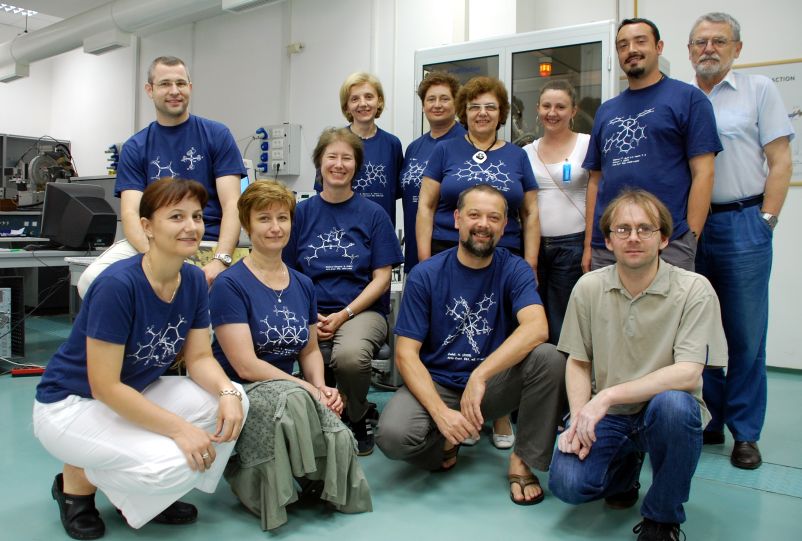
Crystallographers in the Laboratory of General and Inorganic Chemistry,
Department of Chemistry, Faculty of Science, University of Zagreb: (in
front, from left to right) Marijana Đaković, Marina Tašner, Nenad Judaš,
Zoran Bojanić, (sitting) Dubravka Matković-Čalogović, (back, from left
to right) Dominik Cinčić, Biserka Prugovečki, Draginja Mrvoš-Sermek,
Zora Popović, Marija Zbačnik, Vladimir Stilinović, Branko Kaitner
|